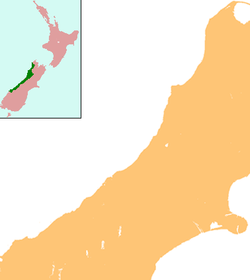Franz Josef / Waiau
Franz Josef / Waiau | |
|---|---|
| Coordinates: 43°23′21″S 170°10′55″E / 43.38917°S 170.18194°E | |
| Country | New Zealand |
| Region | West Coast |
| District | Westland District |
| Electorates | West Coast-Tasman Te Tai Tonga |
| Population (2006) | |
| • Total | 330 |
| Time zone | UTC+12 (NZST) |
| • Summer (DST) | UTC+13 (NZDT) |
| Postcode | 7886 |
| Area code | 03 |
| Local iwi | Ngāi Tahu |
Franz Josef / Waiau is a small town in the West Coast region of the South Island of New Zealand. Whataroa is 32 kilometres (20 mi) to the north-east, and the township of Fox Glacier is 23 kilometres (14 mi) to the south-west. State Highway 6 runs through the town. The Waiho River runs from the Franz Josef Glacier to the south, through the town, and into the Tasman Sea to the north-west.[1][2]
The population was 330 in the 2006 census, an increase of 9 from 2001.[3]
The town is named after the Franz Josef Glacier – itself named by Julius von Haast in honour of the Emperor of Austria Franz Josef I of Austria. Following the passage of the Ngai Tahu Claims Settlement Act 1998, the name of the town was officially altered to Franz Josef / Waiau.[4]
The glacier's terminal face is 5 kilometres (3 mi) from the town and its accessibility makes it a major tourist attraction and the reason many people visit Franz Josef. The town is within the Westland Tai Poutini National Park.
Franz Josef offers many accommodation options for the up to 2,000 people staying overnight during the main season, ranging from hotels and motels to holiday houses, camping sites and backpacker accommodation. Other amenities include a petrol station, small but busy heliport and a number of restaurants and shops.[5] The village is connected to the Franz Josef Glacier valley via walking tracks and a small sealed road leading into the valley from the highway just south of the village.
Franz Josef village is also home to the West Coast Wildlife Centre, developed in 2010 and dedicated to hatching and rearing the world's two rarest species of kiwi, the rowi and Haast tokoeka. The centre offers bookings for behind the scenes tours of its kiwi hatching and rearing facilities.[6]
Education
Franz Josef Glacier School is a coeducational full primary (year 1–8) school with a roll of 42 students as of February 2024.[7] The nearest secondary school is South Westland Area School, 62 km (39 mi) away in Hari Hari.
References
- ^ Peter Dowling (editor) (2004). Reed New Zealand Atlas. Reed Books. map 74. ISBN 0-7900-0952-8.
{{cite book}}:|author=has generic name (help); Unknown parameter|nopp=ignored (|no-pp=suggested) (help) - ^ Roger Smith, GeographX (2005). The Geographic Atlas of New Zealand. Robbie Burton. map 173. ISBN 1-877333-20-4.
{{cite book}}: Unknown parameter|nopp=ignored (|no-pp=suggested) (help) - ^ Quickstats about Franz Josef
- ^ "Ngai Tahu Claims Settlement Act 1998". Retrieved 28 March 2016.
- ^ "Franz Josef Glacier Village". Tourism New Zealand. Retrieved 19 March 2015.
- ^ Anna Turner (20 July 2012). "Influx of kiwi eggs forces centre expansion". The Press. Retrieved 19 March 2015.
- ^ "New Zealand Schools Directory". New Zealand Ministry of Education. Retrieved 14 March 2024.
External links
 Franz Josef travel guide from Wikivoyage
Franz Josef travel guide from Wikivoyage


